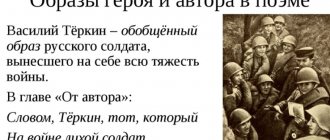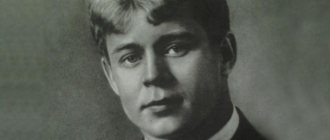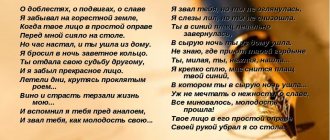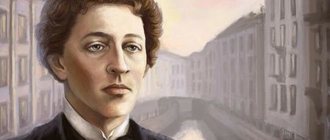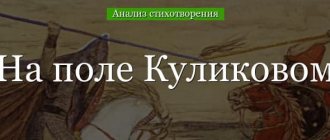The revolutionary unrest of the early twentieth century in Russia evoked responses from many writers. The events of 1917 and the Civil War inspired the creation of works by both contemporaries and writers of later periods, right up to the present day. Among the poets who were inspired by this period of Russian history was A.A. Block. The poem “The Twelve” reflected the author’s ambiguous perception of the coup, the meaning of which is still being wondered about. The rich symbolism of the work has a large number of interpretations.
Symbols: role and their meaning
What does a symbol mean to a poet? It’s the same as a term for a scientist, that is, with the help of it you can express a thought more succinctly, without unnecessary words. And Blok actively took advantage of this opportunity in his work.
- Colors. The first thing the reader encounters in the poem is the antithesis of colors - black and white. In world culture, these shades have dozens of meanings, but for this particular poem, white is renewal, the desire for the future, black is the darkness of the old world, the suffering of the soul caused by sin. In addition, the text contains red, expressing resistance and desire for change.
- Wind is a sign of storm and revolution. He is trying to stir up the snow to bring in everything that is old and experienced.
- 12 is a number with a special meaning. The number of Red Army soldiers in the poem is comparable to the many apostles at the Last Supper. There are many hypotheses about what author’s position is hidden behind the Gospel symbolism. Perhaps for Blok the events of the 17th year are comparable in significance in the history of mankind to Holy Week.
The image of the revolutionary era in the poem by A.A. Block "Twelve".
Composition.
A revolution, like a thunderstorm, like a snowstorm, always brings something new and unexpected; she cruelly deceives many; she easily cripples the worthy in her whirlpool; she often brings the unworthy to land unharmed; but this does not change either the general direction of the flow or that menacing and deafening noise. This noise is still about great things.” (From Blok’s article “Intellectuals and Revolution”) Blok enthusiastically accepted the October Revolution. The October Revolution discovered Blok as an artist, inspired him to create “12,” his best work, after finishing which he was usually mercilessly strict with himself and said: “Today I am a genius!” In “12,” Blok, with enormous inspiration and brilliant skill, captured the image of the Motherland liberated by the revolution that was revealed to him in romantic fires and snowstorms. He understood and accepted the October Revolution as a spontaneous, uncontrollable “world fire”, in the purifying fire of which the entire old world should burn without a trace. This perception of the October Revolution had both strengths and weaknesses. The poet heard primarily one “music” in the revolution - the music of destruction. Mercilessly, “with holy malice,” he condemned and branded in his poem this rotten world with its bourgeoisie, young ladies, and priests. But the rational, organized, creative principle of the socialist revolution did not receive the same complete and clear artistic embodiment in “12”. In the heroes of the poem, the Red Guards, who selflessly went out to storm the old world, perhaps there is more from the anarchist “freedom” (actively active in the October days) than from the vanguard of the Petrograd working class, which, under the leadership of the Bolshevik Party, ensured the victory of the revolution. Wind, blizzard, blizzard, snow are images that symbolize the elements of a cleansing revolutionary storm, the strength and power of popular action. The work is based on the conflict between old and new. Their irreconcilability is emphasized by the sharp contrast of “black” and “white”. Blok seemed to put the image of Christ at the head of his Red Guards. The poet proceeded from his subjective (and completely clear to himself) ideas about early Christianity as a “religion of slaves,” imbued with rebellious sentiments and leading to the collapse of the old, pagan world. In this Blok saw a certain historical similarity with the collapse of tsarist landowner-bourgeois Russia. But certain inconsistencies and contradictions in “12” are redeemed by the high revolutionary pathos that completely permeates this wonderful work, a living sense of greatness and the world-historical significance of October. “They walk into the distance with a sovereign step,” says the poem about its heroes. Away, that is, into the distant future, and precisely with a sovereign step, that is, as new masters of life, builders of a young proletarian power. This is the main and fundamental thing that determines the meaning and historical significance of “12” as a majestic monument of the October era. The poem “12” made the name of A. Blok truly popular. Its lines were transferred to posters, newspaper columns, and to the banners of the first military units of the Red Army. “Listen to the Revolution with all your body, with all your heart,” the poet urged. Blok's clear and strong voice welcomed the revolution as a new day of peace.
Images
- It is important to emphasize the role and image of the author in “The Twelve”. Blok realized that he was present at an epoch-making event; he intuitively sensed the coming changes in the country, which is why in this work “The Writer is a Vitia”, and the poem itself is associated more with a chronicle. Here the poet plays the role of Pimen or Nestor, whose goal is to capture what is happening.
- Let us turn to the image of the twelve Red Guards. Not everyone is named by name, but it is no coincidence that the characters named in the poem coincide with the apostles. Such a mention makes it possible to attach to the characters the largest number of associations evoked in the reader. Ivan, Andrey, Peter - these names are both sacred and social at the same time.
- For example, Petrukha repents of killing out of jealousy, but this hero would not be so significant for the poem if his name were not an allusion to Peter, who renounced Christ. In both cases, crime is not a reason to leave the path, but stimulates you to move on with even greater zeal. Both for Blok’s Peter and for the Evangelical Peter there was no time to regret what they had done: they needed to move forward to realize the common idea.
- The most discussed image in the poem is Christ (an essay on his role in the work is available at the link ). It is interesting to see how it appears in the poem. At the beginning of the poem there is wind, in the 12th chapter a red flag appears in this element, the same attribute in the hands of Christ. It can be assumed that the Savior is present in the poem from the first lines, but in the form of a spirit, a breath, and finds its embodiment only at the end of the work. What does this image mean for the poem? It is unfair to consider that this is a sign of the author's approval of the events of 1917. Blok realized the inevitability of revolution, the impossibility of returning to the old order. The world has become different, the old world is a thing of the past, the country is on the threshold of a new era. The previous one began with Christ and the apostles. And they didn’t disappear anywhere: the scenery changed, but the main characters remained.
Author: Alexandra Barbashova
Interesting? Save it on your wall!
Red color in Blok's poem
For Blok, white is always accompanied by red. It is believed that the first color people noticed was red. Ancient myths associated the creation of man with the color red. Russian peasants of the 19th and early 20th centuries wore red wedding attire. Traditionally, the color red signifies love, warmth, joy, passion, and power. In folk culture, red is contrasted with white as not white, colored. Red is the color of health, life, fertility, sun. At the same time, red is the color of the other world. In ancient times, it was used as a symbol of life, health, and as a talisman. It was believed that the color red could protect from wolves, snakes, mice, as well as from bad weather and evil spirits. This color is associated with blood and fire. The meaning of red is manifested in words such as valuable, beautiful, ceremonial, wonderful. According to popular beliefs, “women in red” are harbingers of misfortune.
Finished works on a similar topic
Course work Symbolism of color in A. Blok’s poem “Twelve” 440 ₽ Abstract Symbolism of color in A. Blok’s poem “Twelve” 230 ₽ Test paper Symbolism of color in A. Blok’s poem “Twelve” 210 ₽
Receive completed work or specialist advice on your educational project Find out the cost
In contrasting colors, white and red mean health, light, and black and yellow mean darkness, death, disease.
The color red also has negative, negative meanings, being a symbol of sin, violence, murder, retribution, and demonic forces.
Note 2
The color red in Blok’s work is the color of combustion; it symbolizes the fire of the revolution.
According to critics, “red” and “white” in A. Blok’s poem “The Twelve” is the dualism of Chaos and Cosmos, God and the Devil, Path and Discourse, Christ and Antichrist. These symbols are balanced in the ghostly, mysterious figure of Jesus Christ, who walks ahead of the detachment “in a white crown of roses” through the bloody snow.
The poem, long perceived as revolutionary, has a much deeper meaning. The reader sees Christ leading the twelve apostles under a red bloody flag. However, this does not mean that Christ sanctifies terror. "The Twelve" is a poem more religious than revolutionary, and the symbolic white corolla of roses is the mystical white rose, the holy blood. The poet combines red and white, blasphemy and holiness into one. An unstoppable element, which is also expressed in the carnival style of the work - this is what the red color expresses. And the red flag is a symbol of the bloody present and victorious end.
“Symbolic images and their meaning in the poem “The Twelve””
The poem “The Twelve” is one of A. Blok’s best works. Blok based the poem on the events of the Russian Revolution of 1917. The author shows us the collapse of the old and the advent of the new world. The entire poem is thoroughly imbued with symbolism, and although A. Blok used symbolism in many of his works, a completely new type of artistic work appears before us. The principle of dissonance is present directly throughout the poem. The images of the poem are complex and contradictory. A. Blok portrays the revolution as an uncontrollable element. For example, images of a blizzard, wind: Black evening, Warm snow. Wind, wind! The man is not standing on his feet. Wind, wind - All over God's world!
In the poem, Blok contrasts the old world with the new, and the black with white. The wreckage of the old world: the bourgeoisie, the comrade priest, the lady in karakul - is replaced by the collective image of twelve Red Guards, representatives of the new world. Twelve is the key number of the poem. Many associations can be associated with this number. First of all, it is twelve hours - midnight, twelve months - the end of the year. The result is some kind of borderline number, since the end of the old year, or day, and the beginning of a new one is the predetermination of a kind of milestone. For Blok, this milestone was the fall of the old world. Another numerical association is the twelve apostles. This is indirectly indicated by the names of two of them - Andryukha and Petrukha. In the revolution, A. Blok saw not only positive, but also negative features. The revolutionaries did anything, even robbery and murder:
Light up the floors, Today there will be robberies! Unlock the cellars - the bastard is on the loose today!
The only event in the poem - the murder of Katka - speaks of the same thing. Everything happens as a spontaneous act. At the end of the poem, twelve Red Guards walk through a snowstorm. Behind them trudges a “hungry dog,” personifying the old world, and in front is Jesus Christ with a “bloody flag.” “Bloody Flag” is associated not only with the color of the revolutionary banners, but also with Katka’s blood shed in the poem. The image of Jesus Christ is very complex. This image is almost impossible to reveal. Even Blok himself could not explain why he placed this image at the end of the poem. Thanks to the symbolism, the short poem turned out to be very capacious. Blok captured the essence of the revolution in his poem and did it with great skill. He subtly portrayed the revolutionary era. I cannot say definitively whether Blok supported the revolution, but I believe that the critics who said that Blok glorified the revolution were wrong.
Essays
Immediately after the revolutionary events, Alexander Alexandrovich Blok wrote his famous poem “The Twelve”. How did it happen that the writer chose such a bloody topic? But he chose her for a reason. Blok truly believed that the revolution could radically change people's lives for the better. He believed in it so much, believed that the revolution was capable of burning out all the rubbish surrounding people that prevented them from living in a wonderful new world. So the poem Twelve appears, where we can observe images of the old and new worlds, where the old world is an old woman, a writer-vitia, prostitutes, a bourgeois, a tramp and a rootless dog.
The image of the Red Army soldiers in the poem
Further in the poem, images of Red Army soldiers appear. This is a collective image of twelve people, which we associate with the twelve apostles. They appear in the poem for a reason. By this, Blok shows that many people strive to change the old world. Shows the collective will of the people, and not someone’s individual opinion. It is with the image of the Red Guards in poem 12 that the idea of the new world, which we see in the created image of the heroes, is connected. These are rifle belts, a cigarette in the mouth, a cap on the head, and all around is the ghost of freedom without a cross.
The twelve apostles of the new world are ready to fight enemies, fulfilling their revolutionary duty; they are representatives of the popular element, entrusted with the mission of defending the revolution, no matter what. Even though their path runs through death and cruelty. In this freedom they see an anarchic free spirit, the embodiment of their dreams, against the old foundations, against the established rules. We see how the Red Army soldiers make their way through the blizzard, succumbing to instincts, without really imagining what awaits them there ahead. By creating the image of the Red Army soldiers, the author reveals permissiveness and shows violence without which change is impossible. At the same time, Blok himself believes that without chaos it is impossible to achieve harmony in the future.
The Red Army soldiers are followed by an old dog, which they brush aside, because this dog is a legacy of the old world. But they are worried about what is hiding there ahead. And there the image of Christ appears as a symbol of the spiritual and moral ideal of people. We see how the Red Army soldiers in a friendly manner call the stranger comrade, but at the same time they themselves shoot at him.
Is this the kind of world A. Blok dreamed of? After all, in the end, the revolution simply destroyed order, faith in God and did not change the people themselves. Maybe that’s why the poet, before his death, wished for this work to be destroyed?
Save it to your wall so you don’t lose it!
